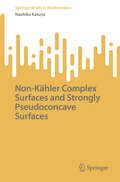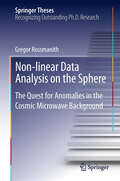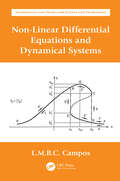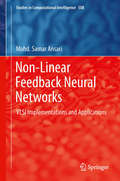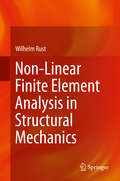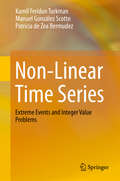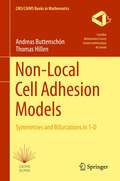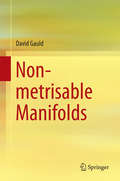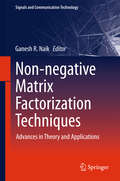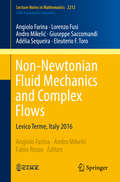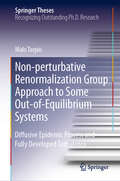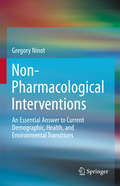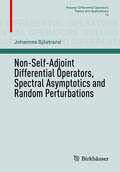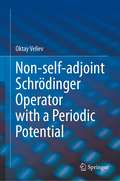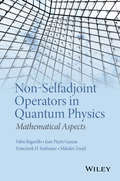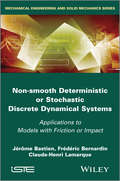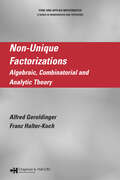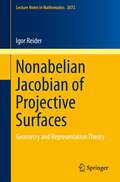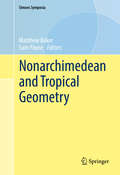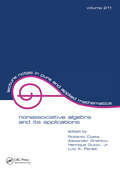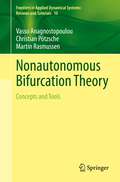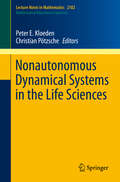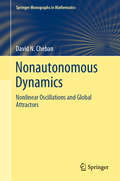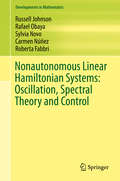- Table View
- List View
Non-Kähler Complex Surfaces and Strongly Pseudoconcave Surfaces (SpringerBriefs in Mathematics)
by Naohiko KasuyaThe main themes of this book are non-Kähler complex surfaces and strongly pseudoconcave complex surfaces. Though there are several notable examples of compact non-Kähler surfaces, including Hopf surfaces, Kodaira surfaces, and Inoue surfaces, these subjects have been regarded as secondary to Kähler manifolds and strongly pseudoconvex manifolds. Recently, however, the existence of uncountably many non-Kähler complex structures on the 4-dimensional Euclidean space has been shown by Di Scala, Kasuya, and Zuddas through their construction. Furthermore, Kasuya and Zuddas' handlebody construction reveals that strongly pseudoconcave surfaces have flexibility with respect to both four-dimensional topology and boundary contact structures. These constructions are based on the knowledge of differential topology and contact geometry, and provide examples of fruitful applications of these areas to complex geometry. Thus, for (especially non-compact) non-Kähler complex surfaces and strongly pseudoconcave complex surfaces, it is not an exaggeration to say that the research is still in its infancy, with numerous areas yet to be explored and expected to develop in the future.
Non-linear Data Analysis on the Sphere
by Gregor RossmanithThis work deals with the search for signatures of non-Gaussianities in the cosmic microwave background (CMB). Probing Gaussianity in the CMB addresses one of the key questions in modern cosmology because it allows us to discriminate between different models of inflation, and thus concerns a fundamental part of the standard cosmological model. The basic goal here is to adapt complementary methods stemming from the field of complexity science to CMB data analysis. Two key concepts, namely the method of surrogates and estimators for local scaling properties, are applied to CMB data analysis. All results show strong non-Gaussianities and pronounced asymmetries. The consistency of the full sky and cut sky results shows convincingly for the first time that the influence of the Galactic plane is not responsible for these deviations from Gaussianity and isotropy. The findings seriously call into question predictions of isotropic cosmologies based on the widely accepted single field slow roll inflation model.
Non-Linear Differential Equations and Dynamical Systems (Mathematics and Physics for Science and Technology)
by Luis Manuel Braga da Costa CamposNon-Linear Differential Equations and Dynamical Systems is the second book within Ordinary Differential Equations with Applications to Trajectories and Vibrations, Six-volume Set. As a set, they are the fourth volume in the series Mathematics and Physics Applied to Science and Technology. This second book consists of two chapters (chapters 3 and 4 of the set). The first chapter considers non-linear differential equations of first order, including variable coefficients. A first-order differential equation is equivalent to a first-order differential in two variables. The differentials of order higher than the first and with more than two variables are also considered. The applications include the representation of vector fields by potentials. The second chapter in the book starts with linear oscillators with coefficients varying with time, including parametric resonance. It proceeds to non-linear oscillators including non-linear resonance, amplitude jumps, and hysteresis. The non-linear restoring and friction forces also apply to electromechanical dynamos. These are examples of dynamical systems with bifurcations that may lead to chaotic motions. Presents general first-order differential equations including non-linear like the Ricatti equation Discusses differentials of the first or higher order in two or more variables Includes discretization of differential equations as finite difference equations Describes parametric resonance of linear time dependent oscillators specified by the Mathieu functions and other methods Examines non-linear oscillations and damping of dynamical systems including bifurcations and chaotic motions
Non-Linear Feedback Neural Networks: VLSI Implementations and Applications
by Mohd. Samar AnsariThis book aims to present a viable alternative to the Hopfield Neural Network (HNN) model for analog computation. It is well known the standard HNN suffers from problems of convergence to local minima, and requirement of a large number of neurons and synaptic weights. Therefore, improved solutions are needed. The non-linear synapse neural network (NoSyNN) is one such possibility and is discussed in detail in this book. This book also discusses the applications in computationally intensive tasks like graph coloring, ranking, and linear as well as quadratic programming. The material in the book is useful to students, researchers and academician working in the area of analog computation.
Non-Linear Finite Element Analysis in Structural Mechanics
by Wilhelm RustThis monograph describes the numerical analysis of non-linearities in structural mechanics, i. e. large rotations, large strain (geometric non-linearities), non-linear material behaviour, in particular elasto-plasticity as well as time-dependent behaviour, and contact. Based on that, the book treats stability problems and limit-load analyses, as well as non-linear equations of a large number of variables. Moreover, the author presents a wide range of problem sets and their solutions. The target audience primarily comprises advanced undergraduate and graduate students of mechanical and civil engineering, but the book may also be beneficial for practising engineers in industry.
Non-Linear Time Series
by Kamil Feridun Turkman Manuel González Scotto Patrícia Zea BermudezThis book offers a useful combination of probabilistic and statistical tools for analyzing nonlinear time series. Key features of the book include a study of the extremal behavior of nonlinear time series and a comprehensive list of nonlinear models that address different aspects of nonlinearity. Several inferential methods, including quasi likelihood methods, sequential Markov Chain Monte Carlo Methods and particle filters, are also included so as to provide an overall view of the available tools for parameter estimation for nonlinear models. A chapter on integer time series models based on several thinning operations, which brings together all recent advances made in this area, is also included. Readers should have attended a prior course on linear time series, and a good grasp of simulation-based inferential methods is recommended. This book offers a valuable resource for second-year graduate students and researchers in statistics and other scientific areas who need a basic understanding of nonlinear time series.
Non-Local Cell Adhesion Models: Symmetries and Bifurcations in 1-D (CMS/CAIMS Books in Mathematics #1)
by Andreas Buttenschön Thomas HillenThis monograph considers the mathematical modeling of cellular adhesion, a key interaction force in cell biology. While deeply grounded in the biological application of cell adhesion and tissue formation, this monograph focuses on the mathematical analysis of non-local adhesion models. The novel aspect is the non-local term (an integral operator), which accounts for forces generated by long ranged cell interactions. The analysis of non-local models has started only recently, and it has become a vibrant area of applied mathematics. This monograph contributes a systematic analysis of steady states and their bifurcation structure, combining global bifurcation results pioneered by Rabinowitz, equivariant bifurcation theory, and the symmetries of the non-local term. These methods allow readers to analyze and understand cell adhesion on a deep level.
Non-metrisable Manifolds
by David GauldManifolds fall naturally into two classes depending on whether they can be fitted with a distance measuring function or not. The former, metrisable manifolds, and especially compact manifolds, have been intensively studied by topologists for over a century, whereas the latter, non-metrisable manifolds, are much more abundant but have a more modest history, having become of increasing interest only over the past 40 years or so. The first book on this topic, this book ranges from criteria for metrisability, dynamics on non-metrisable manifolds, Nyikos's Bagpipe Theorem and whether perfectly normal manifolds are metrisable to structures on manifolds, especially the abundance of exotic differential structures and the dearth of foliations on the long plane. A rigid foliation of the Euclidean plane is described. This book is intended for graduate students and mathematicians who are curious about manifolds beyond the metrisability wall, and especially the use of Set Theory as a tool.
Non-negative Matrix Factorization Techniques
by Ganesh R. NaikThis book collects new results, concepts and further developments of NMF. The open problems discussed include, e. g. in bioinformatics: NMF and its extensions applied to gene expression, sequence analysis, the functional characterization of genes, clustering and text mining etc. The research results previously scattered in different scientific journals and conference proceedings are methodically collected and presented in a unified form. While readers can read the book chapters sequentially, each chapter is also self-contained. This book can be a good reference work for researchers and engineers interested in NMF, and can also be used as a handbook for students and professionals seeking to gain a better understanding of the latest applications of NMF.
Non-Newtonian Fluid Mechanics and Complex Flows: Levico Terme, Italy 2016 (Lecture Notes in Mathematics #2212)
by Eleuterio F. Toro Adélia Sequeira Fabio Rosso Giuseppe Saccomandi Andro Mikelić Angiolo FarinaThis book presents a series of challenging mathematical problems which arise in the modeling of Non-Newtonian fluid dynamics. It focuses in particular on the mathematical and physical modeling of a variety of contemporary problems, and provides some results. The flow properties of Non-Newtonian fluids differ in many ways from those of Newtonian fluids. Many biological fluids (blood, for instance) exhibit a non-Newtonian behavior, as do many naturally occurring or technologically relevant fluids such as molten polymers, oil, mud, lava, salt solutions, paint, and so on. The term "complex flows" usually refers to those fluids presenting an "internal structure" (fluid mixtures, solutions, multiphase flows, and so on). Modern research on complex flows has increased considerably in recent years due to the many biological and industrial applications.
Non-perturbative Renormalization Group Approach to Some Out-of-Equilibrium Systems: Diffusive Epidemic Process and Fully Developed Turbulence (Springer Theses)
by Malo TarpinThis thesis presents the application of non-perturbative, or functional, renormalization group to study the physics of critical stationary states in systems out-of-equilibrium. Two different systems are thereby studied. The first system is the diffusive epidemic process, a stochastic process which models the propagation of an epidemic within a population. This model exhibits a phase transition peculiar to out-of-equilibrium, between a stationary state where the epidemic is extinct and one where it survives. The present study helps to clarify subtle issues about the underlying symmetries of this process and the possible universality classes of its phase transition. The second system is fully developed homogeneous isotropic and incompressible turbulence. The stationary state of this driven-dissipative system shows an energy cascade whose phenomenology is complex, with partial scale-invariance, intertwined with what is called intermittency. In this work, analytical expressions for the space-time dependence of multi-point correlation functions of the turbulent state in 2- and 3-D are derived. This result is noteworthy in that it does not rely on phenomenological input except from the Navier-Stokes equation and that it becomes exact in the physically relevant limit of large wave-numbers. The obtained correlation functions show how scale invariance is broken in a subtle way, related to intermittency corrections.
Non-Pharmacological Interventions: An Essential Answer to Current Demographic, Health, and Environmental Transitions
by Gregory NinotNon-pharmacological interventions (NPIs) have become essential solutions for better living, preventing disease, and self-care, in addition to biomedical treatments, and for increasing longevity without loss of quality of life. Over the past 20 years, these practices have gone from general diet and hygiene advice to targeted and personalized solutions for prevention, care optimization, and curative treatments. Selected empirically for centuries or recently with the help of technological innovations and epigenetic, interventional, and medico-economic studies, their development is growing and diversifying around the world. Today an NPI ecosystem is made up of a myriad of public and private actors. As interest in NPIs grows, so do questions about safety, effectiveness, standardization, ethical practice, and surveillance. In this book, the author answers these questions with a scientific approach, because evidence-based science, evidence-based practice, clinical research, and data monitoring have revolutionized this field. Topics explored among the chapters include: · Defining Non-Pharmacological Interventions · The Benefits and Dangers of Non-Pharmacological Interventions · Motives and Facilitators of Non-Pharmacological Intervention Use · The Market for Non-Pharmacological Interventions · Evaluation of Non-Pharmacological Interventions · The Future of Non-Pharmacological Interventions Non-Pharmacological Interventions: An Essential Answer to Current Demographic, Health, and Environmental Transitions is a must-have resource for clinicians and other health professionals, researchers, students, health insurers, policy-makers, caregivers, and entrepreneurs in the health and wellness space, as well as any users who wish to inform themselves about NPIs.
Non-Riemannian Geometry (Dover Books on Mathematics #8)
by Luther Pfahler EisenhartNon-Riemannian Geometry deals basically with manifolds dominated by the geometry of paths developed by the author, Luther Pfahler Eisenhart, and Oswald Veblen, who were faculty colleagues at Princeton University during the early twentieth century. Eisenhart played an active role in developing Princeton's preeminence among the world's centers for mathematical study, and he is equally renowned for his achievements as a researcher and an educator.In Riemannian geometry, parallelism is determined geometrically by this property: along a geodesic, vectors are parallel if they make the same angle with the tangents. In non-Riemannian geometry, the Levi-Civita parallelism imposed a priori is replaced by a determination by arbitrary functions (affine connections). In this volume, Eisenhart investigates the main consequences of the deviation.Starting with a consideration of asymmetric connections, the author proceeds to a contrasting survey of symmetric connections. Discussions of the projective geometry of paths follow, and the final chapter explores the geometry of sub-spaces.
Non-Self-Adjoint Differential Operators, Spectral Asymptotics and Random Perturbations (Pseudo-Differential Operators #14)
by Johannes SjöstrandThe asymptotic distribution of eigenvalues of self-adjoint differential operators in the high-energy limit, or the semi-classical limit, is a classical subject going back to H. Weyl of more than a century ago.In the last decades there has been a renewed interest in non-self-adjoint differential operators which have many subtle properties such as instability under small perturbations. Quite remarkably, when adding small random perturbations to such operators, the eigenvalues tend to distribute according to Weyl's law (quite differently from the distribution for the unperturbed operators in analytic cases). A first result in this direction was obtained by M. Hager in her thesis of 2005. Since then, further general results have been obtained, which are the main subject of the present book.Additional themes from the theory of non-self-adjoint operators are also treated. The methods are very much based on microlocal analysis and especially on pseudodifferential operators. The reader will find a broad field with plenty of open problems.
Non-self-adjoint Schrödinger Operator with a Periodic Potential
by Oktay VelievThis book gives a complete spectral analysis of the non-self-adjoint Schrödinger operator with a periodic complex-valued potential. Building from the investigation of the spectrum and spectral singularities and construction of the spectral expansion for the non-self-adjoint Schrödinger operator, the book features a complete spectral analysis of the Mathieu-Schrödinger operator and the Schrödinger operator with a parity-time (PT)-symmetric periodic optical potential. There currently exists no general spectral theorem for non-self-adjoint operators; the approaches in this book thus open up new possibilities for spectral analysis of some of the most important operators used in non-Hermitian quantum mechanics and optics. Featuring detailed proofs and a comprehensive treatment of the subject matter, the book is ideally suited for graduate students at the intersection of physics and mathematics.
Non-Selfadjoint Operators in Quantum Physics
by Franciszek Hugon Szafraniec Jean-Pierre Gazeau Fabio Bagarello Miloslav ZnojilA unique discussion of mathematical methods with applications to quantum mechanics Non-Selfadjoint Operators in Quantum Physics: Mathematical Aspects presents various mathematical constructions influenced by quantum mechanics and emphasizes the spectral theory of non-adjoint operators. Featuring coverage of functional analysis and algebraic methods in contemporary quantum physics, the book discusses the recent emergence of unboundedness of metric operators, which is a serious issue in the study of parity-time-symmetric quantum mechanics. The book also answers mathematical questions that are currently the subject of rigorous analysis with potentially significant physical consequences. In addition to prompting a discussion on the role of mathematical methods in the contemporary development of quantum physics, the book features: Chapter contributions written by well-known mathematical physicists who clarify numerous misunderstandings and misnomers while shedding light on new approaches in this growing area An overview of recent inventions and advances in understanding functional analytic and algebraic methods for non-selfadjoint operators as well as the use of Krein space theory and perturbation theory Rigorous support of the progress in theoretical physics of non-Hermitian systems in addition to mathematically justified applications in various domains of physics such as nuclear and particle physics and condensed matter physics An ideal reference, Non-Selfadjoint Operators in Quantum Physics: Mathematical Aspects is useful for researchers, professionals, and academics in applied mathematics and theoretical and/or applied physics who would like to expand their knowledge of classical applications of quantum tools to address problems in their research. Also a useful resource for recent and related trends, the book is appropriate as a graduate-level and/or PhD-level text for courses on quantum mechanics and mathematical models in physics.
Non-Smooth Deterministic or Stochastic Discrete Dynamical Systems: Applications to Models with Friction or Impact
by Jerome Bastien Frederic Bernardin Claude-Henri LamarqueThis book contains theoretical and application-oriented methods to treat models of dynamical systems involving non-smooth nonlinearities. The theoretical approach that has been retained and underlined in this work is associated with differential inclusions of mainly finite dimensional dynamical systems and the introduction of maximal monotone operators (graphs) in order to describe models of impact or friction. The authors of this book master the mathematical, numerical and modeling tools in a particular way so that they can propose all aspects of the approach, in both a deterministic and stochastic context, in order to describe real stresses exerted on physical systems. Such tools are very powerful for providing reference numerical approximations of the models. Such an approach is still not very popular nevertheless, even though it could be very useful for many models of numerous fields (e.g. mechanics, vibrations, etc.). This book is especially suited for people both in research and industry interested in the modeling and numerical simulation of discrete mechanical systems with friction or impact phenomena occurring in the presence of classical (linear elastic) or non-classical constitutive laws (delay, memory effects, etc.). It aims to close the gap between highly specialized mathematical literature and engineering applications, as well as to also give tools in the framework of non-smooth stochastic differential systems: thus, applications involving stochastic excitations (earthquakes, road surfaces, wind models etc.) are considered. Contents 1. Some Simple Examples. 2. Theoretical Deterministic Context. 3. Stochastic Theoretical Context. 4. Riemannian Theoretical Context. 5. Systems with Friction. 6. Impact Systems. 7. Applications–Extensions. About the Authors Jérôme Bastien is Assistant Professor at the University Lyon 1 (Centre de recherche et d'Innovation sur le sport) in France. Frédéric Bernardin is a Research Engineer at Département Laboratoire de Clermont-Ferrand (DLCF), Centre d'Etudes Techniques de l'Equipement (CETE), Lyon, France. Claude-Henri Lamarque is Head of Laboratoire Géomatériaux et Génie Civil (LGCB) and Professor at Ecole des Travaux Publics de l'Etat (ENTPE), Vaulx-en-Velin, France.
Non-Unique Factorizations: Algebraic, Combinatorial and Analytic Theory (Chapman & Hall/CRC Pure and Applied Mathematics)
by Alfred Geroldinger Franz Halter-KochFrom its origins in algebraic number theory, the theory of non-unique factorizations has emerged as an independent branch of algebra and number theory. Focused efforts over the past few decades have wrought a great number and variety of results. However, these remain dispersed throughout the vast literature. For the first time, Non-Unique Factoriza
Nonabelian Jacobian of Projective Surfaces
by Igor ReiderThe Jacobian of a smooth projective curve is undoubtedly one of the most remarkable and beautiful objects in algebraic geometry. This work is an attempt to develop an analogous theory for smooth projective surfaces - a theory of the nonabelian Jacobian of smooth projective surfaces. Just like its classical counterpart, our nonabelian Jacobian relates to vector bundles (of rank 2) on a surface as well as its Hilbert scheme of points. But it also comes equipped with the variation of Hodge-like structures, which produces a sheaf of reductive Lie algebras naturally attached to our Jacobian. This constitutes a nonabelian analogue of the (abelian) Lie algebra structure of the classical Jacobian. This feature naturally relates geometry of surfaces with the representation theory of reductive Lie algebras/groups. This work's main focus is on providing an in-depth study of various aspects of this relation. It presents a substantial body of evidence that the sheaf of Lie algebras on the nonabelian Jacobian is an efficient tool for using the representation theory to systematically address various algebro-geometric problems. It also shows how to construct new invariants of representation theoretic origin on smooth projective surfaces.
Nonarchimedean and Tropical Geometry
by Matthew Baker Sam PayneThisvolume grew out of two Simons Symposia on "Nonarchimedean and tropicalgeometry" which took place on the island of St. John in April 2013 and inPuerto Rico in February 2015. Each meeting gathered a small group of expertsworking near the interface between tropical geometry and nonarchimedeananalytic spaces for a series of inspiring and provocative lectures on cuttingedge research, interspersed with lively discussions and collaborative work insmall groups. The articles collected here, which include high-level surveys aswell as original research, mirror the main themes of the two Symposia. Topicscovered in this volume include: Differential forms and currents, andsolutions of Monge-Ampere type differential equations on Berkovich spaces andtheir skeletons; The homotopy types of nonarchimedean analytifications; The existence of "faithful tropicalizations" which encode the topology andgeometry of analytifications; Relations between nonarchimedean analyticspaces and algebraic geometry, including logarithmic schemes, birationalgeometry, and the geometry of algebraic curves; Extended notions oftropical varieties which relate to Huber's theory of adic spaces analogously tothe way that usual tropical varieties relate to Berkovich spaces; and Relationsbetween nonarchimedean geometry and combinatorics, including deep andfascinating connections between matroid theory, tropical geometry, and Hodgetheory.
NonasSociative Algebra and Its Applications: The Fourth International Conference (Lecture Notes In Pure And Applied Mathematics Ser. #Vol. 211)
by Roberto Costa Alexander Grishkov Henrique Guzzo Jr. Luiz A. PeresiA collection of lectures presented at the Fourth International Conference on Nonassociative Algebra and its Applications, held in Sao Paulo, Brazil. Topics in algebra theory include alternative, Bernstein, Jordan, lie, and Malcev algebras and superalgebras. The volume presents applications to population genetics theory, physics, and more.
Nonautonomous Bifurcation Theory: Concepts and Tools (Frontiers in Applied Dynamical Systems: Reviews and Tutorials)
by Vasso Anagnostopoulou Christian Pötzsche Martin RasmussenBifurcation theory is a major topic in dynamical systems theory with profound applications. However, in contrast to autonomous dynamical systems, it is not clear what a bifurcation of a nonautonomous dynamical system actually is, and so far, various different approaches to describe qualitative changes have been suggested in the literature. The aim of this book is to provide a concise survey of the area and equip the reader with suitable tools to tackle nonautonomous problems. A review, discussion and comparison of several concepts of bifurcation is provided, and these are formulated in a unified notation and illustrated by means of comprehensible examples. Additionally, certain relevant tools needed in a corresponding analysis are presented.
Nonautonomous Dynamical Systems in the Life Sciences
by Peter E. Kloeden Christian PötzscheNonautonomous dynamics describes the qualitative behavior of evolutionary differential and difference equations, whose right-hand side is explicitly time dependent. Over recent years, the theory of such systems has developed into a highly active field related to, yet recognizably distinct from that of classical autonomous dynamical systems. This development was motivated by problems of applied mathematics, in particular in the life sciences where genuinely nonautonomous systems abound. The purpose of this monograph is to indicate through selected, representative examples how often nonautonomous systems occur in the life sciences and to outline the new concepts and tools from the theory of nonautonomous dynamical systems that are now available for their investigation.
Nonautonomous Dynamics: Nonlinear Oscillations and Global Attractors (Springer Monographs in Mathematics)
by David N. ChebanThis book emphasizes those topological methods (of dynamical systems) and theories that are useful in the study of different classes of nonautonomous evolutionary equations. The content is developed over six chapters, providing a thorough introduction to the techniques used in the Chapters III-VI described by Chapter I-II. The author gives a systematic treatment of the basic mathematical theory and constructive methods for Nonautonomous Dynamics. They show how these diverse topics are connected to other important parts of mathematics, including Topology, Functional Analysis and Qualitative Theory of Differential/Difference Equations. Throughout the book a nice balance is maintained between rigorous mathematics and applications (ordinary differential/difference equations, functional differential equations and partial difference equations). The primary readership includes graduate and PhD students and researchers in in the field of dynamical systems and their applications (control theory, economic dynamics, mathematical theory of climate, population dynamics, oscillation theory etc).
Nonautonomous Linear Hamiltonian Systems: Oscillation, Spectral Theory and Control
by Russell Johnson Rafael Obaya Sylvia Novo Carmen Núñez Roberta FabbriThis monograph contains an in-depth analysis of the dynamics given by a linear Hamiltonian system of general dimension with nonautonomous bounded and uniformly continuous coefficients, without other initial assumptions on time-recurrence. Particular attention is given to the oscillation properties of the solutions as well as to a spectral theory appropriate for such systems. The book contains extensions of results which are well known when the coefficients are autonomous or periodic, as well as in the nonautonomous two-dimensional case. However, a substantial part of the theory presented here is new even in those much simpler situations. The authors make systematic use of basic facts concerning Lagrange planes and symplectic matrices, and apply some fundamental methods of topological dynamics and ergodic theory. Among the tools used in the analysis, which include Lyapunov exponents, Weyl matrices, exponential dichotomy, and weak disconjugacy, a fundamental role is played by the rotation number for linear Hamiltonian systems of general dimension. The properties of all these objects form the basis for the study of several themes concerning linear-quadratic control problems, including the linear regulator property, the Kalman-Bucy filter, the infinite-horizon optimization problem, the nonautonomous version of the Yakubovich Frequency Theorem, and dissipativity in the Willems sense. The book will be useful for graduate students and researchers interested in nonautonomous differential equations; dynamical systems and ergodic theory; spectral theory of differential operators; and control theory.
